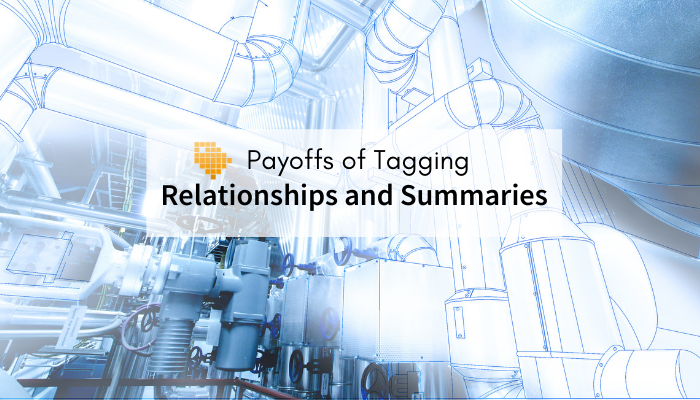The home of smart buildings, smart equipment and IoT

Tagging and data modeling have numerous benefits in the Buildings industry. In a recent blog, we discussed the challenges in the industry that are being solved by Project Haystack. Now, we will look at some practical examples of how tagging and data modeling is being used by the Haystack community in a variety of applications and use cases in a series of seven blogs (the seven payoffs). This blog highlights the payoffs of relationships and summaries.
Tags that reflect relationships are useful for showing how devices interrelate as part of a larger system. Relationship, or reference tags can also represent dependencies of equipment to floors, floors to buildings, buildings to enterprise, etc. Additional relationships can be represented with reference tags to help define systems:
- Air systems: AHUs to VAVs
- Water systems - hot water coils to boiler
- Electrical systems - sub meters to main meters
For example, reference tags can be used to build the hierarchical relationships of all the VAV’s in a particular air handler system. This makes it possible to call up equipment summaries. These summaries can be viewed from multiple perspectives such as all the VAVs on a floor or even the VAVs on an entire site. Anomalies are particularly easy to spot when they are presented in the context of other similar devices.
![]()
To read more about all of the payoffs, click here and download the complete whitepaper. To watch how to implement tagging using great software like FIN, check out the video below.
Scott joined J2 Innovations as a partner in 2011, and is now Vice President of Customer Experience. He has a wide range of responsibilities including evangelism, business development, training, and operational excellence. Scott is well known as an industry expert in smarthomes and smart buildings. He is a past president of ASHRAE, and is currently a board member for Project Haystack. Scott attended Clarkson University for Mechanical Engineering and graduated with a BS/Business in Organizational Innovation.
Topics from this blog: Project Haystack
Back to all posts
J2 Innovations Headquarters, 535 Anton Blvd, Suite 1200, Costa Mesa, CA 92626, USA. Tel: 909-217-7040